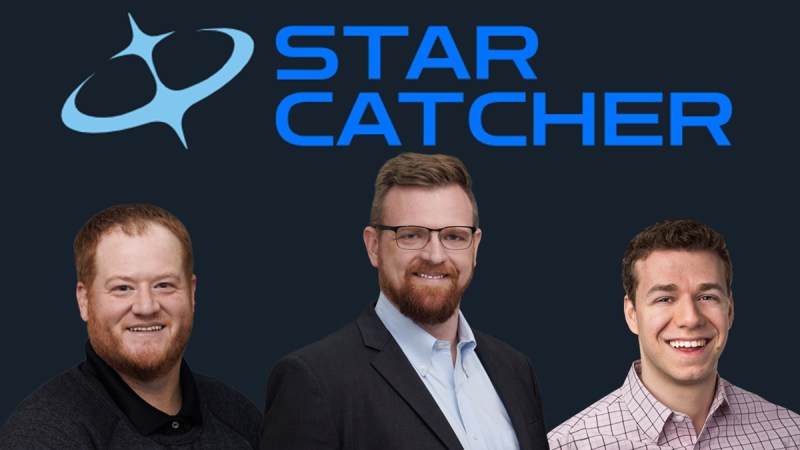



Join our daily and weekly newsletters for the latest updates and exclusive content on industry-leading AI coverage. Learn More
Star Catcher Industries has raised $12.25 million in seed funding to provide an energy grid in space for satellites.
With this funding, the Jacksonville, Florida-based company is positioned to help eliminate power constraints on space operations through the construction of its Star Catcher Network, the world’s first space-based energy grid. Once constructed, the Star Catcher Network will be a first-of-its-kind energy grid able to beam significant levels of broad spectrum energy to spacecraft in Low Earth Orbit (“LEO”) and beyond.
It’s kind of like a gas station in space, only for solar power. And it can provide more energy to the batteries of satellites than the solar panels on many spacecraft.
“Throughout my career and my personal life, I just want to enable us to do more in space to commercialize space and industrialize space,” said Andrew Rush, CEO of Star Catcher, in an interview with VentureBeat. “The biggest constraint on spacecraft today on commercialization and industrialization of space is power availability. You can drop the cost of launch with reusable rockets from SpaceX and Rocket Lab, but we still are really constrained in the amount of power that is available on spacecraft.”
Rush added, “And so that’s why we started here to alleviate that constraint on satellite operations.”
Origins
Star Catcher was founded at the beginning of 2024 by longtime space entrepreneurs Andrew Rush and Michael Snyder, alongside experienced VC investor and operator Bryan Lyandvert. Snyder and Rush have been working together for a decade.
Rush previously served as CEO & President of in-space manufacturing trailblazer Made In Space, where he led the company through its successful sale to Redwire Corporation in 2020. Following the sale, Rush became Redwire’s founding president and COO, where he managed hundreds of millions of dollars of development and delivery contracts for commercial, civil, and national security customers. He has spearheaded programs and initiatives that include replacing solar arrays on the International Space Station, delivering multiple shipsets of solar arrays and spacecraft navigation components for national security customers, and developing and delivering camera systems for the Artemis I mission.
Snyder served alongside Rush as cofounder and chief engineer of Made In Space and CTO of Redwire. One of the most accomplished space technologists of the modern era, Snyder has flown over a dozen payloads to space and holds more than 50 patents on a wide variety of cutting-edge space technologies.
Snyder is the 2022 recipient of the AIAA Lawrence Sperry Award for notable contributions made to the aerospace industry.
Meanwhile, Lyandvert is a well-known space investor with extensive experience in early-stage investing and capital formation from his time at MetaProp Ventures and T-Bird Capital. Earlier in his career, Lyandvert worked at Amazon, managing a big wearables business.
Lyandvert said in an interview that the company raised the $12.25 million from a cold start from several core investors. The company has 11 people and it is hiring.
A big problem
Handling communications from space is a very power-hungry service, Rush said.
“The SpaceX approach is to build the world’s largest rocket to brute force it and have enormous solar panels on each one of their spacecraft. So they’re really expensive,” Rush said. “Our approach is more of an elegant solution. We’re augmenting the power of much smaller assets and enhancing them that way.”
With LEO projected to host more than 40,000 satellites by 2030, Star Catcher anticipates a need for 840 megawatts of power generation to operate these systems, compared to the tens of megawatts of power generation capacity in space today. That’s enough to power 840,000 homes for one hour.
Rush said that the problem for satellites has been around for most of his career, but only in the recent months have they figured out some of the solutions.
How it works
The network will deliver energy on demand and at higher concentrations of energy than the sun to the
existing solar arrays of client spacecraft enabling them to generate up to five to ten times the amount of
power they would generate otherwise without retrofit. Demand for high-performing, power-intensive applications in space, including space-based telecommunications, on orbit computing, remote sensing, human spaceflight, and national security applications, is growing exponentially.
“We will be building a constellation of power satellites that operate in low-Earth orbit and service satellites in low-Earth orbit. The way that this works is that we don’t require retrofit on the part of our customers,” Rush said. “We beam them power in the solar spectrum, essentially,” Rush said. “And we bring that power to their existing solar arrays. So they don’t need a special receiver on their spacecraft. We don’t have this chicken and the egg problem of needing to put that on the satellites before they are compatible with us.”
You can see some of the details in the rendered image above. The power nodes (top of the render, gold spacecraft) collect a significant amount of power from sunlight (several hundred kilowatts worth) and then send energy to multiple (50 to 100 depending on demand and customer density) spacecraft simultaneously in the form of broad spectrum energy (mostly visible and near infrared as this is what spacecraft solar arrays are highly efficient at converting to electricity) directly to the client spacecraft solar arrays (see the representative light gold beams going to the client spacecraft). Star Catcher get the desired power levels and orbital elements for each client spacecraft from the client in advance so it can track and acquire their spacecraft and send the appropriate amount of energy to them.
“You can think of it as a really fancy flashlight,” Rush said. “And we but what we do is everybody has a very focused flashlight. And we’re able to steer a light beam and we’re able to vary the amount of power that we’re sending.”
Rush said that one of the ways that satellites fail in orbit is batteries degrade to the point where they can no longer hold enough charge to keep the satellite alive. It’s like when your cell phone battery starts wearing out.
By providing spacecraft with higher concentrations of energy to state-of-the-art solar arrays, the Star Catcher Network will significantly magnify space-based power generation to meet this growing demand and enable satellite operators to expand capabilities and uptime while reducing upfront spend.
“One of the key insights that we had when forming the company is that we want to limit the amount of retrofit that clients’ satellites need to have in order to really drive adoption,” Lyandvert said. “I think 90% plus of satellites have solar panels on them. The light that we’re sending them is specifically designed to be eaten by that solar panel. And so that’s, that’s how the technology works.”
A satellite might have a lifetime of so many watts of power, but Star Catcher wants to provide perhaps five or 10 times more.
The Star Catcher grid will have a series of collectors that are made up of reflectors. They capture the light and redirect it, but they don’t need to hold the solar energy in a solar cell and convert it into electricity. It simply captures the light and redirects it.
Star Catcher calls its grid satellites “power nodes.” The company is not yet disclosing how much the systems costs at this stage, Rush said. The system will have to be able to collect sunlight, concentrate it and then redirect that power to satellites.
By December 2025, the company hopes to fly a subscale demonstrator satellite to prove out the technology on orbit. Then it wil build the large-scale commercial power nodes to send into space.
“The timing is really right for this because we have so many satellites in lower orbit now. And they’re growing, and they’re going to grow by about an order of magnitude by the end of the decade,” Rush said.
In order to cover all orbits in low-Earth orbit, the company would need to deploy about 200 satellites.
Infrastructure of power in space
Initialized Capital and B Capital co-led the round, with meaningful participation from Rogue VC.
“Power infrastructure is the foundational building block of civilization and industry; our goal is to expand
that foundation into LEO and beyond with our in-space power grid and service,” said Rush. “Being able to buy power for your spacecraft whenever and wherever you need it in LEO will expand opportunity and accelerate humanity realizing the potential of the second golden age of space.”
Star Catcher said it has made significant technical progress in developing its constellation and has achieved early traction, securing more than half a dozen letters of intent from commercial space companies spanning the remote sensing, national security, human habitat, and telecommunications verticals.
“Most any maturing sector requires solid, dependable, ubiquitous infrastructure to really take off. We’re
confident Star Catcher will do for orbital power what SpaceX has done for launch. They’re a proven,
veteran commercial space team executing on an audacious vision at high speed. What they’re building
has the potential to transform the economics, capabilities, and even configuration of most everything
we put into orbit,” said Andrew Sather, principal at Initialized Capital, in a statement.
A lot of support
Initialized’s portfolio—which spans over six core funds —is worth close to $200 billion in market value
with 25 companies valued at $1 billion or more and five valued over $10 billion.
With this seed funding, Star Catcher’s immediate focus will be on validating and demonstrating its
power beaming services for customers, beginning with ground demonstrations, followed by an on-orbit
demonstration in late 2025, and deployment of commercial service. Once deployed, satellite operators
can shift to a shared infrastructure mindset, where power consumption will not be constrained by what
satellites bring with them.
“As a longtime space sector investor, I view the network Star Catcher is developing as one of the most
potentially transformational technologies in the dynamic and continuously evolving space technology
sector. Satellite launch costs continue to fall, and power needs are accelerating with onboard processing. At the same time, energy demand is vastly outstripping the supply that current solar panels and batteries provide. Star Catcher’s founders are drawing from their extensive industry experience to tackle this opportunity with a unique approach. At B Capital, we support pioneering founders and companies shaping our future through technology and are confident Star Catcher has the vision, roadmap, and team to build the core infrastructure that will power and reshape the future space economy,” said Howard Morgan, general partner of B Capital, in a statement.
The company plans to do its first demo of a satellite in December. The company is setting up a number of relationships with partners and customers.


